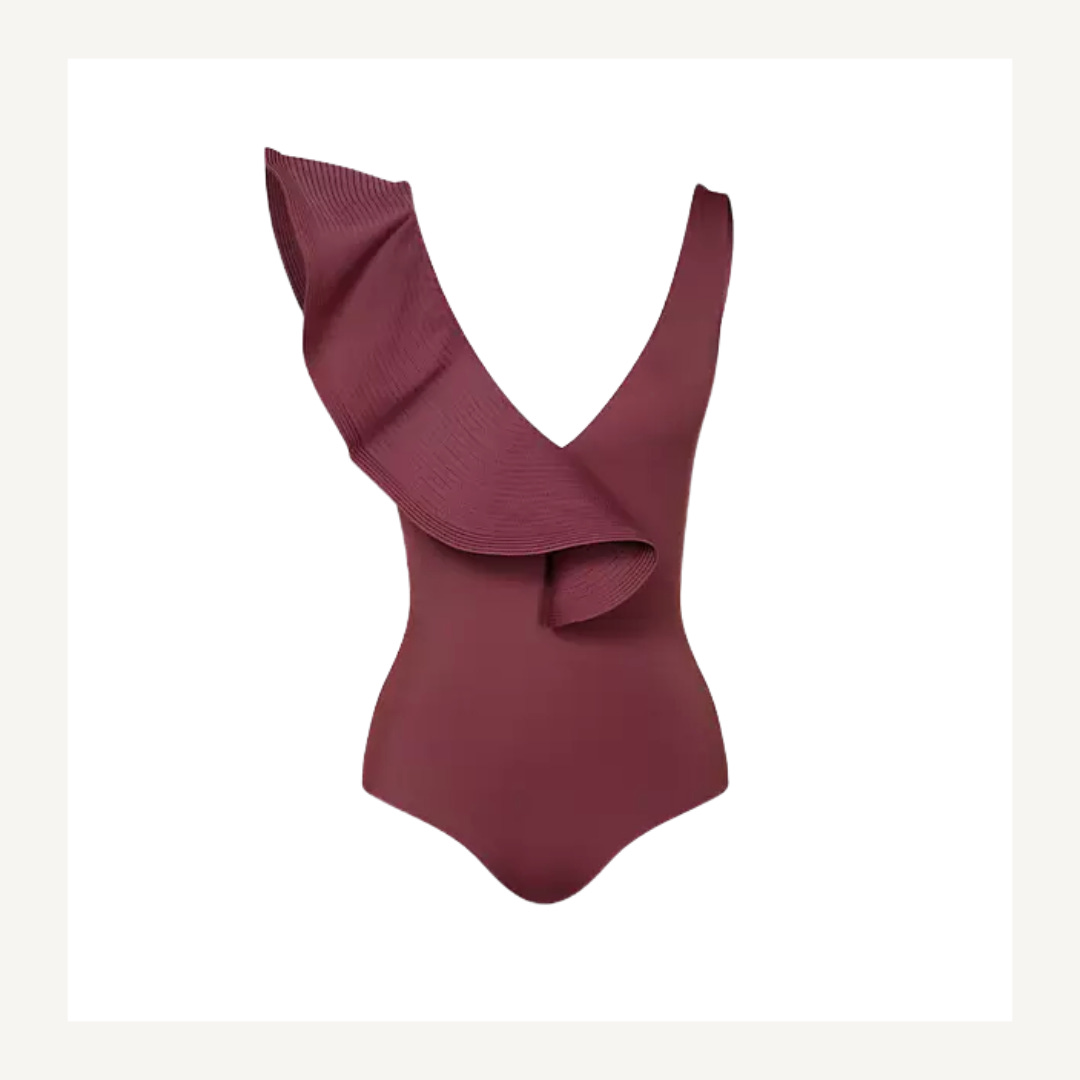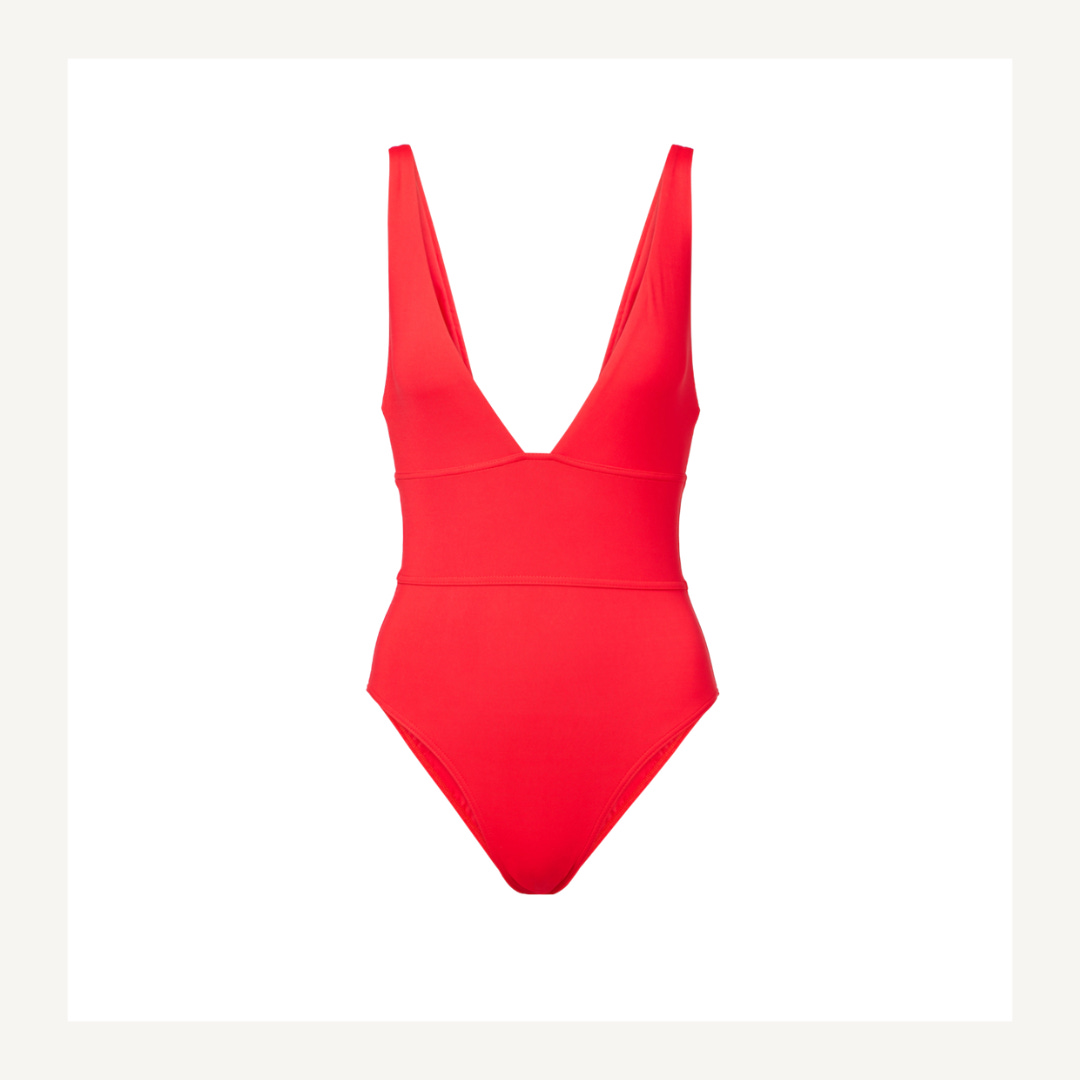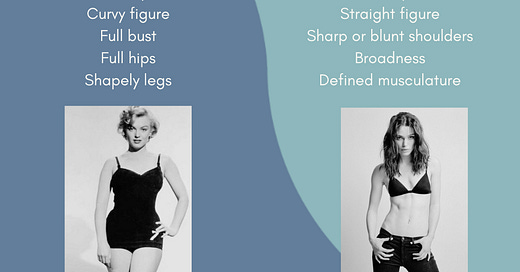No garment reveals your natural lines more honestly than a swimsuit—which is why finding the right one can feel so tricky. Unlike a dress or a pair of pants, where layers and clever tailoring can reshape or distract, a swimsuit puts your body architecture front and center.
One of the most effective ways to approach the challenge of finding a great swimsuit is by paying attention to the lines your body already creates—the shapes, angles, and proportions present in your face and frame. When the lines of any garment echo the lines of your body, something clicks: the piece doesn’t just fit, it feels like it belongs on you. Apply that philosophy to swimwear, and you move beyond simply reaching for a pretty suit—you choose one that feels intentional and harmonious. Silhouette, fabric, pattern, and detail all play a role in whether a suit supports that sense of ease or feels at odds with your natural design.
Softness and sharpness: reading the lines of your body
So how do you recognize the lines a swimsuit should echo? One helpful lens is the balance of yin and yang—the interplay of softness and sharpness, curve and angle, delicacy and strength. I wrote more fully about this concept [here], but at its core, the framework is about honoring the unique mix of these opposing forces within each of us. Some bodies express more yang through height, long vertical lines, sharp features, or broad structure. Others lean toward yin with petite stature, curved lines, or lush features. While we all carry a combination of both, many of us will skew toward one side of the spectrum—more yin or more yang.
What the Kibbe types add to the picture
If yin and yang describe the forces at play, the Kibbe Image Identity System (often called Kibbe types) offers a way to categorize how those forces combine—and provides a map for how to use that knowledge when getting dressed. Introduced by image consultant and author David Kibbe in the 1980s, this system classifies women into one of 13 types, based on their distinctive balance of yin and yang qualities. I’ve written more about this framework and how it connects to personal style [here].
The Kibbe system arranges its 13 types along a spectrum from yin-dominant to yang-dominant, with several types that blend these forces in different proportions. Some lean distinctly toward softness, curve, and delicacy—hallmarks of yin—while others express sharpness, strength, and verticality, qualities of yang. Between these poles are types that reflect varying degrees of balance, contrast, or harmony between the two.
In the next section, we’ll walk through each of the types along this spectrum—with notes on their defining characteristics, the kinds of swimsuit silhouettes that complement their lines, and examples of styles that align with their natural design.
The swimsuit spectrum: matching silhouettes to Kibbe types
Romantic
yin/yang balance: Most yin of the Kibbe types
key characteristics: Curvy figure; often petite to moderate in height with full bust and hips; soft facial features such as rounded cheeks, large eyes, full lips, or a rounded nose
swimsuit details that work well: Curve-enhancing cuts like underwired balconette tops, sweetheart necklines, and high-waisted bottoms; soft details like ruching, delicate straps, or floral patterns
why these details work: Romantics shine in styles that emphasize softness and shape. Swimsuits that echo curved lines and feminine details feel harmonious on this body type—highlighting the natural beauty of rounded features rather than working against them.

Theatrical Romantic
yin/yang balance: Predominantly yin with a hint of yang sharpness
key characteristics: Curvy, but with more defined bone structure than Romantics (e.g., prominent cheekbones, narrow or tapered shoulders); often petite to moderate in height with full bust and hips
swimsuit details that work well: Curve-enhancing suits with a hint of drama—such as halter styles with plunging necklines; soft detailing like ruching or draping combined with sharp accents like sculptural hardware or sleek straps
why these details work: Theatrical Romantics need both curve emphasis and a little edge to reflect their unique proportion of yin and yang.

Soft Gamine
yin/yang balance: A juxtaposing mix of yin and yang with more yin influence
key characteristics: Compact and petite; slightly rounded body lines (e.g., shapely legs, sloped shoulders); facial features that combine fullness (e.g., round cheeks, large eyes) with sharpness (e.g., angular cheekbones, pointed chin)
swimsuit details that work well: Suits with playfully feminine details that remain neat rather than overly soft—like contrast piping, dainty ruffles, bows, or button accents; small-scale prints like polka dots, ditzy florals, or gingham; side-tie bottoms; broken lines through two-piece styles or subtle pattern play
why these details work: Soft Gamines thrive in styles that reflect both their yin sweetness and their yang punch. A mix of soft shapes with sharper accents captures their girly essence without overwhelming their frame. Two-piece silhouettes, small-scale prints, or contrast trims gently disrupt the line in a way that feels lively but harmonious.

Gamine
yin/yang balance: A juxtaposing mix of yin and yang
key characteristics: Petite, compact frame with sharp edges or angular bone structure; may have square shoulders without broadness; limbs tend to be short relative to height, contributing to a compact, slightly staccato silhouette; often features a mix of soft and sharp facial traits (e.g., round eyes paired with a pointed chin or angular cheekbones); youthful, animated presence
swimsuit details that work well: High-energy, playful designs with crisp structure—like bold colorblocking, contrast piping, or two-piece sets with clever cutouts; small- to medium-scale graphic prints such as stripes, checkerboard, or geometrics; structured tops like bandeaus, sporty bralettes, or triangle styles paired with low- or mid-rise bottoms
why these details work: Gamines thrive in looks that reflect their vibrant, high-contrast structure. Clean, tailored shapes with playful or unexpected details highlight their lively, staccato essence—while serious or overly soft designs can feel at odds with their spirited lines.

Soft Classic
yin/yang balance: A balanced blend of yin and yang with more yin influence
key characteristics: Symmetrical proportions (e.g., legs and arms appear neither short nor long); petite to moderate height; slightly rounded edges (e.g., rounded shoulders, shapely calves); facial features are even and harmonious, often with soft or slightly rounded qualities (e.g., gentle cheekbones, soft jawline)
swimsuit details that work well: Simple, elegant cuts with soft refinement—such as scoop necklines, subtle sweetheart shapes, or lightly ruched one-pieces; clean lines with polished, understated details like twist fronts, refined hardware, or small-scale prints
why these details work: Soft Classics shine in designs that respect their natural symmetry and add just a touch of softness. Styles that are too sharp or overly frilly tend to feel off balance; soft structure and quiet elegance highlight their poised, harmonious lines.

Classic
yin/yang balance: Pure balance between yin and yang
key characteristics: Symmetrical proportions (e.g., legs and arms appear neither short nor long); moderate height; neither particularly sharp nor particularly soft; facial features are balanced and symmetrical without pronounced angularity or fullness
swimsuit details that work well: Clean, streamlined silhouettes—such as sleek one-pieces, simple tank styles, or minimal bikinis with medium-width straps; solid colors or restrained patterns like narrow stripes; polished finishes and refined hardware rather than overt embellishment
why these details work: Classics look best in elegant, understated designs that echo their natural balance and grace. Dramatic, intricate, or overly playful styles can feel mismatched against their innate simplicity.

Dramatic Classic
yin/yang balance: A balanced blend of yin and yang with more yang influence
key characteristics: Symmetrical proportions (e.g., legs and arms appear neither short nor long); moderate to slightly tall height; slightly sharp edges (e.g., defined shoulders, hint of muscularity); facial features are even and harmonious but with a strong, controlled presence (e.g., sharper cheekbones, firmer jawline)
swimsuit details that work well: Sleek, tailored cuts with understated drama—such as high necklines, one-shoulder designs, or structured bandeau tops with architectural seaming; solids or geometric prints; polished metal hardware like rings or bars for subtle edge
why these details work: Dramatic Classics thrive in styles that combine structure with sophistication. Their blend of balance and yang is best supported by streamlined designs with just enough sharpness to reinforce their natural presence—without overpowering their refinement.

Flamboyant Gamine
yin/yang balance: A juxtaposing mix of yin and yang with more yang influence
key characteristics: Petite to moderate height with a compact frame; sharp or angular bone structure (e.g., square or broad shoulders, lightly defined musculature); long limbs relative to height (often leggier or coltish); facial features frequently show a mix of soft and sharp (e.g., full lips paired with sharp cheekbones or a pointed chin)
swimsuit details that work well: Crisp, structured two-piece styles—like triangle tops, bandeaus, or sporty bikini sets; small- to medium-scale graphic prints such as checkerboard or stripes; contrasting details like piping, zippers, or buckles; broken lines through two-piece designs, color blocking, or unexpected seaming that interrupts vertical flow
why these details work: Flamboyant Gamines come alive in designs that reflect their playful sharpness. Suits that combine structure with punchy details mirror their energetic mix of compactness and edge. Breaking their vertical line—whether through a two-piece silhouette, color blocking, or striking seaming—reinforces their lively, staccato essence.

Soft Natural
yin/yang balance: Primarily yang with soft yin undercurrents
key characteristics: Broad or muscular bone structure with some curves softening the frame (e.g., fleshy fullness at bust, hips, or thighs); moderate to slightly tall height; often described as athletic or sturdy; facial features may combine width or bluntness (e.g., square jawline, broad nose) with gentle softness (e.g., rounded cheeks, full lips)
swimsuit details that work well: Relaxed cuts with gentle drape—such as halter tops, soft wrap styles, or one-pieces with ruching, gathers, or twist details; flowing or organic prints; textures like ribbed fabrics; hardware made from natural materials like tortoiseshell rings, wood accents, or rope ties
why these details work: Soft Naturals glow in styles that reflect their blend of strength and softness. Overly stiff or sharply tailored suits can feel at odds with their ease, while softly structured designs with a touch of movement and organic texture feel aligned with their natural, unforced grace.

Natural
yin/yang balance: Strongly yang in a blunt or broad manner rather than a sharp one
key characteristics: Broad, straight bone structure with minimal curves; moderate to slightly tall height; often described as athletic or sturdy; shoulders tend to be broad or square; facial features may be wide or square-shaped with blunt edges (e.g., wide-set eyes, straight eyebrows, square jawline)
swimsuit details that work well: Uncomplicated, relaxed styles with clean lines—like athletic-inspired cuts, simple scoop necks, or classic tank suits; matte or gently textured fabrics like crinkle stretch or linen-look weaves; minimal or earthy hardware (e.g., rope ties, wood rings); larger-scale prints like tribal patterns, animal prints, or geometrics
why these details work: Often associated with the "girl next door" aesthetic, Naturals look most at home in styles that feel unfussy and relaxed. Swimsuits that are simple, sporty, and unforced highlight their approachable beauty—while overly delicate or rigid tailoring tends to feel disconnected from their straightforward charm.

Flamboyant Natural
yin/yang balance: Boldly yang, expressed through blunt broadness with added verticality
key characteristics: Broad, angular bone structure (e.g., broad shoulders, wide ribcage) with extended vertical lines (e.g., long arms, legs, or torso); moderate to tall height; often athletic or slightly muscular frame; facial features tend to be prominent or striking (e.g., high cheekbones, wide-set eyes, square or broad jawline)
swimsuit details that work well: Bold, relaxed styles that emphasize strength and length—such as plunging necklines, asymmetrical cuts, or high-leg one-pieces; clean silhouettes with standout details like cutouts, strappy designs, or strong hardware; earthy textures like crinkle fabrics or matte finishes; larger-scale prints, stripes, or graphic colorblocking
why these details work: Flamboyant Naturals shine in swimsuits that reflect their powerful blend of broadness and verticality. Structured but never stiff, these styles highlight their bold lines while allowing freedom and ease. Overly delicate, intricate, or “cute” details tend to feel at odds with their striking presence—whereas strong, unfussy designs feel perfectly aligned with their natural energy.

Soft Dramatic
yin/yang balance: Yang-dominant verticality with yin softness
key characteristics: Tall or above-average height; elongated, angular bone structure (e.g., prominent shoulders that are sharp rather than blunt); long limbs, hands, and feet; softened by significant curves (such as a full bust, hips, or thighs); facial features often striking and bold, blending sharpness with lushness (e.g., high cheekbones, full lips, large eyes)
swimsuit details that work well: Bold, glamorous styles that honor both their dramatic scale and softness—such as plunging necklines, draped or ruched one-pieces, halter tops with dramatic ties, or high-cut legs; luxe fabrics with a bit of sheen or texture; standout accents like oversized hardware, metallic rings, or statement belts
why these details work: Soft Dramatics shine when their natural mix of elongated yang and sensual yin is reflected in their styling. Swimsuits that are too minimal, sporty, or plain tend to underplay their commanding presence, while designs that embrace scale, glamour, and curve-enhancing detail feel perfectly at home on their statuesque, high-impact frame.

Dramatic
yin/yang balance: Pure yang—sharp, elongated, and angular
key characteristics: Tall to very tall height with an elongated, narrow frame; angular bone structure (e.g., sharp shoulders, long limbs, narrow hips); little to no natural curve or fleshiness; facial features often striking and chiseled (e.g., strong jawline, high cheekbones, narrow nose, deep-set eyes)
swimsuit details that work well: Sleek, minimalist cuts that emphasize long lines and sharp edges—such as high-neck one-pieces, asymmetrical styles, plunging v-necks, or high-leg cuts that enhance verticality; solid colors or bold, clean colorblocking; structured silhouettes with geometric or architectural elements; polished hardware kept simple and purposeful (e.g., linear metallic accents)
why these details work: Dramatics look powerful and elegant in designs that mirror their chiseled, elongated lines. Overly soft, intricate, or delicate detailing can feel disconnected from their bold clarity. Instead, strong, streamlined silhouettes that emphasize length and structure align beautifully with their commanding, intense presence.

The best swimsuit isn’t the one that hides the most or shows the most—it’s the one that feels like it belongs on you. When you understand the lines your body naturally creates, and choose shapes that echo those lines, even something as minimal as a swimsuit becomes an extension of your presence. Whether your architecture calls for softness or structure, simplicity or bold detail, honoring your natural design allows you to show up at ease and with confidence.





